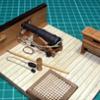
Bob Cleek
-
Posts
3,374 -
Joined
-
Last visited
Reputation Activity
-
 Bob Cleek got a reaction from robert952 in Norwegian Sailing Pram by Claire7 - Model Shipways - 1:12
Bob Cleek got a reaction from robert952 in Norwegian Sailing Pram by Claire7 - Model Shipways - 1:12
Not to worry. No two wooden boats are ever exactly built to plan, even those built to be exactly the same for class racing under exacting measurement rules. There are always small discrepancies, not only from boat to boat, but also from side to side of the same boat. It is not unusual for a boat to have a "faster tack," because the slight differences between the port and starboard sides affect the speed of the boat when on that tack. As noted, nobody will notice. It's a major accomplishment just to finish a kit. I don't know if there are any verifiable statistics, but if the ratio of started to finished build logs are any indication, you've already beat the odds against you.
Nice work!
-
 Bob Cleek got a reaction from Ryland Craze in Norwegian Sailing Pram by Claire7 - Model Shipways - 1:12
Bob Cleek got a reaction from Ryland Craze in Norwegian Sailing Pram by Claire7 - Model Shipways - 1:12
Not to worry. No two wooden boats are ever exactly built to plan, even those built to be exactly the same for class racing under exacting measurement rules. There are always small discrepancies, not only from boat to boat, but also from side to side of the same boat. It is not unusual for a boat to have a "faster tack," because the slight differences between the port and starboard sides affect the speed of the boat when on that tack. As noted, nobody will notice. It's a major accomplishment just to finish a kit. I don't know if there are any verifiable statistics, but if the ratio of started to finished build logs are any indication, you've already beat the odds against you.
Nice work!
-
 Bob Cleek got a reaction from FriedClams in USS Tennessee 1869 by Keith Black - scale 1:120 - Wood Hull Screw Frigate - ex Madawaska 1865
Bob Cleek got a reaction from FriedClams in USS Tennessee 1869 by Keith Black - scale 1:120 - Wood Hull Screw Frigate - ex Madawaska 1865
Excellent photos! I'd bet these are the only photographic evidence of the rigging of early steaming lights available on the internet, or anywhere else for that matter. It speaks well of your "eye" for critical details. A picture is worth a thousand words. If I were judging a model that portrayed such a detail, I'd certainly give it high points and "extra credit" for that!
-
 Bob Cleek got a reaction from mbp521 in USS Tennessee 1869 by Keith Black - scale 1:120 - Wood Hull Screw Frigate - ex Madawaska 1865
Bob Cleek got a reaction from mbp521 in USS Tennessee 1869 by Keith Black - scale 1:120 - Wood Hull Screw Frigate - ex Madawaska 1865
Excellent photos! I'd bet these are the only photographic evidence of the rigging of early steaming lights available on the internet, or anywhere else for that matter. It speaks well of your "eye" for critical details. A picture is worth a thousand words. If I were judging a model that portrayed such a detail, I'd certainly give it high points and "extra credit" for that!
-
 Bob Cleek got a reaction from GrandpaPhil in USS Tennessee 1869 by Keith Black - scale 1:120 - Wood Hull Screw Frigate - ex Madawaska 1865
Bob Cleek got a reaction from GrandpaPhil in USS Tennessee 1869 by Keith Black - scale 1:120 - Wood Hull Screw Frigate - ex Madawaska 1865
Okay, the Sheldon Cooper reference sent me to Google. (I don't watch TV sitcoms.) This is what Wikipedia says (in part) about Sheldon Cooper:
Sheldon Lee Cooper, Ph.D., Sc.D, is a fictional character in the CBS television series The Big Bang Theory and its spinoff series Young Sheldon.
The adult Sheldon is a senior theoretical physicist at The California Institute of Technology (Caltech), ...
He has a genius-level IQ of 187. (In The Big Bang Theory, ... In Young Sheldon, his mother says that he has the same IQ as Albert Einstein and Stephen Hawking, though neither is known to have taken an IQ test.) However, he displays a fundamental lack of social skills, a tenuous understanding of humor, and difficulty recognizing irony and sarcasm in other people, although he himself often employs them. He exhibits highly idiosyncratic behavior and a general lack of humility, empathy, and tolerance. These characteristics provide the majority of the humor involving him, which are credited with making him the show's breakout character.[10][11][12][13] Some viewers have asserted that Sheldon's personality is consistent with autism spectrum disorder (or what used to be classified as Asperger's Syndrome.)[12][14] Co-creator Bill Prady has stated that Sheldon's character was neither conceived nor developed with regard to Asperger's,[14] although Parsons has said that in his opinion, Sheldon "couldn't display more traits" of Asperger's. ...
Sheldon is characterized as being highly intelligent, but he tends to display childish qualities, such as extreme stubbornness and meanness. It is claimed by Bernadette that the reason Sheldon is sometimes mean is because the part of his brain that tells him it is wrong to be mean is "getting a wedgie from the rest of his brain".[29] However, in season 8's "The Space Probe Disintegration", Sheldon tearfully admits to Leonard that he is aware of how his behavior comes across.
Sheldon frequently states that he possesses an eidetic memory (although his powers of autobiographical recall are more like hyperthymesia) and an IQ of 187,[32] although he claims his IQ cannot be accurately measured by normal tests.[33] He originally claimed to have a master's degree and two doctoral degrees, but this list has increased.[34][35] Sheldon possesses a mastery (and extensive knowledge) of various subjects ... (he is a well-known railfan and a fancier of model trains) ... Although his friends have similar intellects to him, his eccentricities, stubbornness, and narcissism frequently frustrate them. ... He dislikes gifts, because the "social convention" in his view creates either a debt or burden on the receiver of the gift which will not stop until one of the two involved in the "gift-relationship" dies leaving the other either in debt or with an undue surplus.[56] Sheldon also does not take drugs, not even legal ones such as caffeine, due to a promise to his mother, and is hypersensitive when he accidentally consumes them.[57][43] However, it has been shown that alcohol often causes Sheldon to loosen up significantly,[6] although it will also cloud his judgment on occasion. After drinking alcoholic drinks (both deliberately and accidentally), he has done things that he would never do while sober, such as singing out loud,[58] mooning an audience full of people,[27] confronting Wil Wheaton,[59] leaving wildly inappropriate voicemails after "drunk dialling" Stephen Hawking, and affectionately slapping Amy's rear.[60] After consuming caffeine in the form of coffee or energy drinks, typically on the rare occasions that he has to work beyond his normal working hours to meet a deadline, he acts in a hyperactive, erratic manner.
In response to criticism from his friends that he is mentally ill, Sheldon often retorts, "I'm not crazy; my mother had me tested"; which his mother has confirmed to be true, once while wishing she had gone through with a follow-up examination.
Both the character and Parsons' portrayal have received widespread acclaim, and is often cited as the main reason for the program's success by both critics and fans.[87][88][89] James Chamberlin of IGN wrote: "It's hard to imagine what The Big Bang Theory would be if it weren't for Jim Parsons' great portrayal of Sheldon Cooper".[90] Matt Roush of TV Guide stated that "there's a spark of divine inspiration in Jim Parsons' uproarious Sheldon Cooper".[91] Ken Tucker of Entertainment Weekly wrote that: "Parsons is doing something rare on network TV: making intellectualism admirable, even heroic".
https://en.wikipedia.org/wiki/Sheldon_Cooper
If there was any intention of comparing me to Sheldon Cooper, that would be grossly unfair and I would have to strenuously object. I only have one doctoral degree.
-
 Bob Cleek got a reaction from mtaylor in solid hull vs. plank on bulkhead/frame
Bob Cleek got a reaction from mtaylor in solid hull vs. plank on bulkhead/frame
Very thin veneer for non-structural planking is hard to source in my experience, at least and there's always the difficulty of working with the grain of wood that has been peeled from the log rather than sawn from it.. It's one thing if the plank is going to define and support the shape of the hull, but on a solid hull, that's not necessary and, consequently, the planking stock can be paper thin and cut with scissors, even, if one wishes. That will permit "planking" in scales well below 1:48 in size.
The way it's done is to take a nice heavy plane, a #5 and better a #7 if you are lucky enough to have one, (or make do with what you've got.) Sharpen the iron well and set it properly to take a paper-thin shaving and then run it down the length of a nice clear plank edge (with the grain, not against it) and plane yourself a nice even curl of wood. Then take those curls, unroll them, and iron them flat with a clothes iron and cut your planks out from those flat ribbons of nice wood with the grain all running in the right direction with a scissors or a scalpel blade and a straight edge. Then glue those "planks" to your solid hull and nobody will ever be the wiser that you didn't spend a lot of time assembling frames and bulkheads and fairing plank edges and so on.
I learned this trick reading the late Gerald Wingrove's book, The Techniques of Ship Modeling. He was working in quite small scale and he even devised a way to stack up razor blades separated by washers bolted together to create a cutter that could be run down the edge of a plank of wood so that a number of evenly spaced razor cuts would be made in the face of the edge of the plank. They he would plane the edge of the plank and the shavings would be simultaneously cut at the same time and all of the same width with one stroke of the plane.
-
 Bob Cleek got a reaction from mtaylor in solid hull vs. plank on bulkhead/frame
Bob Cleek got a reaction from mtaylor in solid hull vs. plank on bulkhead/frame
I've had the same experience exactly and my 12 year old grandson "doesn't feel comfortable" in my workshop building "because it's dusty and full of spider webs." (I think the kid needs to do some time in "Grandpa's Boot Camp!") The schools now have what they call "Maker's Spaces," which are sort of shop classrooms where they are supposedly able to "make things," but I haven't seen anything being "made" nor any manual arts skills being taught. They also have "robotics shop," which is perhaps more technologically up with the times, but seems to only be about assembling prefabricated LEGO subassemblies and playing with radio-controlled cars in a different context. What's more disturbing to me is that kids my grandson's age don't seem to have any desire or interest to build anything. No "forts" or treehouses. No coasters. No working on their bicycles. Just no creative drive. Their interest is consumed by computer games (perhaps as our hobbies now compete with our own screen time... touche'.)
"Reality" doesn't have to be "virtual," but it seems for them, it is. If they want something, their instinct seems to be to find out on line where to buy it. But then again, I had a father-in-law who used to call the Yellow Pages his "tool box" because he was "manually illiterate" and always hired somebody to everything.
Who's going to teach them "righty tighty, lefty loosey?" How will they ever learn to sharpen an edge? (I gave my grandson a small pocket knife and my daughter had a conniption fit and took it away from him because it was "dangerous."
Don't ask me. I still haven't figured out how to gracefully mention to someone in a wooden ship modeling forum that they are pushing their chisel against the grain!
-
 Bob Cleek got a reaction from Ryland Craze in Norwegian Sailing Pram by Claire7 - Model Shipways - 1:12
Bob Cleek got a reaction from Ryland Craze in Norwegian Sailing Pram by Claire7 - Model Shipways - 1:12
The torch will do fine to anneal small brass items, as will a gas stove burner. Get a pair, or better yet, a set, of long locking soldering tweezers for such purposes. They will come in handy for soldering, as well. Amazon.com: Fiber Grip Tweezers Jewelry Hobby Craft Soldering Fiber Grip Cross Locking Set Bent and Straight Tip 5 PCS By JTS : Tools & Home Improvement (I picked this set because it shows a variety of soldering tweezers. I don't know what the quality may be, but the price seemed quite reasonable.)
While you're at it, in the soldering department, and for a lot of other tasks, especially rigging, I'd highly recommend acquiring a Quad Hands "helping hands" device. There are many cheaper Asian copies on the market now, but the original is still the professional industry standard and worth the few additional bucks. (Better materials, stronger magnets, and better clips.) They come in many sizes and configurations. Suit yourself. QuadHands® - Helping Hands Tool
See: https://www.amazon.com/vdp/4c85a9f99b434f8c86151188ebcdf63b?ref=dp_vse_ibvc0
-
 Bob Cleek got a reaction from robert952 in Norwegian Sailing Pram by Claire7 - Model Shipways - 1:12
Bob Cleek got a reaction from robert952 in Norwegian Sailing Pram by Claire7 - Model Shipways - 1:12
Do the instructions say anything about bending those planks? They can be heated up with a clothes iron or hair dryer on high and then quickly (while still hot) bent and held in place for a minute or three. They will hold the bend when they cool. That should save a lot of hassle with rubber bands and tape if ever the occasion might arise again.
-
 Bob Cleek got a reaction from BANYAN in USS Tennessee 1869 by Keith Black - scale 1:120 - Wood Hull Screw Frigate - ex Madawaska 1865
Bob Cleek got a reaction from BANYAN in USS Tennessee 1869 by Keith Black - scale 1:120 - Wood Hull Screw Frigate - ex Madawaska 1865
Excellent photos! I'd bet these are the only photographic evidence of the rigging of early steaming lights available on the internet, or anywhere else for that matter. It speaks well of your "eye" for critical details. A picture is worth a thousand words. If I were judging a model that portrayed such a detail, I'd certainly give it high points and "extra credit" for that!
-
 Bob Cleek got a reaction from Snug Harbor Johnny in solid hull vs. plank on bulkhead/frame
Bob Cleek got a reaction from Snug Harbor Johnny in solid hull vs. plank on bulkhead/frame
Very thin veneer for non-structural planking is hard to source in my experience, at least and there's always the difficulty of working with the grain of wood that has been peeled from the log rather than sawn from it.. It's one thing if the plank is going to define and support the shape of the hull, but on a solid hull, that's not necessary and, consequently, the planking stock can be paper thin and cut with scissors, even, if one wishes. That will permit "planking" in scales well below 1:48 in size.
The way it's done is to take a nice heavy plane, a #5 and better a #7 if you are lucky enough to have one, (or make do with what you've got.) Sharpen the iron well and set it properly to take a paper-thin shaving and then run it down the length of a nice clear plank edge (with the grain, not against it) and plane yourself a nice even curl of wood. Then take those curls, unroll them, and iron them flat with a clothes iron and cut your planks out from those flat ribbons of nice wood with the grain all running in the right direction with a scissors or a scalpel blade and a straight edge. Then glue those "planks" to your solid hull and nobody will ever be the wiser that you didn't spend a lot of time assembling frames and bulkheads and fairing plank edges and so on.
I learned this trick reading the late Gerald Wingrove's book, The Techniques of Ship Modeling. He was working in quite small scale and he even devised a way to stack up razor blades separated by washers bolted together to create a cutter that could be run down the edge of a plank of wood so that a number of evenly spaced razor cuts would be made in the face of the edge of the plank. They he would plane the edge of the plank and the shavings would be simultaneously cut at the same time and all of the same width with one stroke of the plane.
-
 Bob Cleek got a reaction from Canute in solid hull vs. plank on bulkhead/frame
Bob Cleek got a reaction from Canute in solid hull vs. plank on bulkhead/frame
Very thin veneer for non-structural planking is hard to source in my experience, at least and there's always the difficulty of working with the grain of wood that has been peeled from the log rather than sawn from it.. It's one thing if the plank is going to define and support the shape of the hull, but on a solid hull, that's not necessary and, consequently, the planking stock can be paper thin and cut with scissors, even, if one wishes. That will permit "planking" in scales well below 1:48 in size.
The way it's done is to take a nice heavy plane, a #5 and better a #7 if you are lucky enough to have one, (or make do with what you've got.) Sharpen the iron well and set it properly to take a paper-thin shaving and then run it down the length of a nice clear plank edge (with the grain, not against it) and plane yourself a nice even curl of wood. Then take those curls, unroll them, and iron them flat with a clothes iron and cut your planks out from those flat ribbons of nice wood with the grain all running in the right direction with a scissors or a scalpel blade and a straight edge. Then glue those "planks" to your solid hull and nobody will ever be the wiser that you didn't spend a lot of time assembling frames and bulkheads and fairing plank edges and so on.
I learned this trick reading the late Gerald Wingrove's book, The Techniques of Ship Modeling. He was working in quite small scale and he even devised a way to stack up razor blades separated by washers bolted together to create a cutter that could be run down the edge of a plank of wood so that a number of evenly spaced razor cuts would be made in the face of the edge of the plank. They he would plane the edge of the plank and the shavings would be simultaneously cut at the same time and all of the same width with one stroke of the plane.
-
 Bob Cleek got a reaction from Canute in solid hull vs. plank on bulkhead/frame
Bob Cleek got a reaction from Canute in solid hull vs. plank on bulkhead/frame
I've had the same experience exactly and my 12 year old grandson "doesn't feel comfortable" in my workshop building "because it's dusty and full of spider webs." (I think the kid needs to do some time in "Grandpa's Boot Camp!") The schools now have what they call "Maker's Spaces," which are sort of shop classrooms where they are supposedly able to "make things," but I haven't seen anything being "made" nor any manual arts skills being taught. They also have "robotics shop," which is perhaps more technologically up with the times, but seems to only be about assembling prefabricated LEGO subassemblies and playing with radio-controlled cars in a different context. What's more disturbing to me is that kids my grandson's age don't seem to have any desire or interest to build anything. No "forts" or treehouses. No coasters. No working on their bicycles. Just no creative drive. Their interest is consumed by computer games (perhaps as our hobbies now compete with our own screen time... touche'.)
"Reality" doesn't have to be "virtual," but it seems for them, it is. If they want something, their instinct seems to be to find out on line where to buy it. But then again, I had a father-in-law who used to call the Yellow Pages his "tool box" because he was "manually illiterate" and always hired somebody to everything.
Who's going to teach them "righty tighty, lefty loosey?" How will they ever learn to sharpen an edge? (I gave my grandson a small pocket knife and my daughter had a conniption fit and took it away from him because it was "dangerous."
Don't ask me. I still haven't figured out how to gracefully mention to someone in a wooden ship modeling forum that they are pushing their chisel against the grain!
-
 Bob Cleek got a reaction from East Ender in solid hull vs. plank on bulkhead/frame
Bob Cleek got a reaction from East Ender in solid hull vs. plank on bulkhead/frame
I've had the same experience exactly and my 12 year old grandson "doesn't feel comfortable" in my workshop building "because it's dusty and full of spider webs." (I think the kid needs to do some time in "Grandpa's Boot Camp!") The schools now have what they call "Maker's Spaces," which are sort of shop classrooms where they are supposedly able to "make things," but I haven't seen anything being "made" nor any manual arts skills being taught. They also have "robotics shop," which is perhaps more technologically up with the times, but seems to only be about assembling prefabricated LEGO subassemblies and playing with radio-controlled cars in a different context. What's more disturbing to me is that kids my grandson's age don't seem to have any desire or interest to build anything. No "forts" or treehouses. No coasters. No working on their bicycles. Just no creative drive. Their interest is consumed by computer games (perhaps as our hobbies now compete with our own screen time... touche'.)
"Reality" doesn't have to be "virtual," but it seems for them, it is. If they want something, their instinct seems to be to find out on line where to buy it. But then again, I had a father-in-law who used to call the Yellow Pages his "tool box" because he was "manually illiterate" and always hired somebody to everything.
Who's going to teach them "righty tighty, lefty loosey?" How will they ever learn to sharpen an edge? (I gave my grandson a small pocket knife and my daughter had a conniption fit and took it away from him because it was "dangerous."
Don't ask me. I still haven't figured out how to gracefully mention to someone in a wooden ship modeling forum that they are pushing their chisel against the grain!
-
 Bob Cleek got a reaction from East Ender in solid hull vs. plank on bulkhead/frame
Bob Cleek got a reaction from East Ender in solid hull vs. plank on bulkhead/frame
Very thin veneer for non-structural planking is hard to source in my experience, at least and there's always the difficulty of working with the grain of wood that has been peeled from the log rather than sawn from it.. It's one thing if the plank is going to define and support the shape of the hull, but on a solid hull, that's not necessary and, consequently, the planking stock can be paper thin and cut with scissors, even, if one wishes. That will permit "planking" in scales well below 1:48 in size.
The way it's done is to take a nice heavy plane, a #5 and better a #7 if you are lucky enough to have one, (or make do with what you've got.) Sharpen the iron well and set it properly to take a paper-thin shaving and then run it down the length of a nice clear plank edge (with the grain, not against it) and plane yourself a nice even curl of wood. Then take those curls, unroll them, and iron them flat with a clothes iron and cut your planks out from those flat ribbons of nice wood with the grain all running in the right direction with a scissors or a scalpel blade and a straight edge. Then glue those "planks" to your solid hull and nobody will ever be the wiser that you didn't spend a lot of time assembling frames and bulkheads and fairing plank edges and so on.
I learned this trick reading the late Gerald Wingrove's book, The Techniques of Ship Modeling. He was working in quite small scale and he even devised a way to stack up razor blades separated by washers bolted together to create a cutter that could be run down the edge of a plank of wood so that a number of evenly spaced razor cuts would be made in the face of the edge of the plank. They he would plane the edge of the plank and the shavings would be simultaneously cut at the same time and all of the same width with one stroke of the plane.
-
 Bob Cleek got a reaction from robert952 in Norwegian Sailing Pram by Claire7 - Model Shipways - 1:12
Bob Cleek got a reaction from robert952 in Norwegian Sailing Pram by Claire7 - Model Shipways - 1:12
The torch will do fine to anneal small brass items, as will a gas stove burner. Get a pair, or better yet, a set, of long locking soldering tweezers for such purposes. They will come in handy for soldering, as well. Amazon.com: Fiber Grip Tweezers Jewelry Hobby Craft Soldering Fiber Grip Cross Locking Set Bent and Straight Tip 5 PCS By JTS : Tools & Home Improvement (I picked this set because it shows a variety of soldering tweezers. I don't know what the quality may be, but the price seemed quite reasonable.)
While you're at it, in the soldering department, and for a lot of other tasks, especially rigging, I'd highly recommend acquiring a Quad Hands "helping hands" device. There are many cheaper Asian copies on the market now, but the original is still the professional industry standard and worth the few additional bucks. (Better materials, stronger magnets, and better clips.) They come in many sizes and configurations. Suit yourself. QuadHands® - Helping Hands Tool
See: https://www.amazon.com/vdp/4c85a9f99b434f8c86151188ebcdf63b?ref=dp_vse_ibvc0
-
 Bob Cleek got a reaction from mtaylor in USS Tennessee 1869 by Keith Black - scale 1:120 - Wood Hull Screw Frigate - ex Madawaska 1865
Bob Cleek got a reaction from mtaylor in USS Tennessee 1869 by Keith Black - scale 1:120 - Wood Hull Screw Frigate - ex Madawaska 1865
Excellent photos! I'd bet these are the only photographic evidence of the rigging of early steaming lights available on the internet, or anywhere else for that matter. It speaks well of your "eye" for critical details. A picture is worth a thousand words. If I were judging a model that portrayed such a detail, I'd certainly give it high points and "extra credit" for that!
-
 Bob Cleek got a reaction from Dave_E in USS Tennessee 1869 by Keith Black - scale 1:120 - Wood Hull Screw Frigate - ex Madawaska 1865
Bob Cleek got a reaction from Dave_E in USS Tennessee 1869 by Keith Black - scale 1:120 - Wood Hull Screw Frigate - ex Madawaska 1865
Excellent photos! I'd bet these are the only photographic evidence of the rigging of early steaming lights available on the internet, or anywhere else for that matter. It speaks well of your "eye" for critical details. A picture is worth a thousand words. If I were judging a model that portrayed such a detail, I'd certainly give it high points and "extra credit" for that!
-
 Bob Cleek got a reaction from Glen McGuire in USS Tennessee 1869 by Keith Black - scale 1:120 - Wood Hull Screw Frigate - ex Madawaska 1865
Bob Cleek got a reaction from Glen McGuire in USS Tennessee 1869 by Keith Black - scale 1:120 - Wood Hull Screw Frigate - ex Madawaska 1865
Excellent photos! I'd bet these are the only photographic evidence of the rigging of early steaming lights available on the internet, or anywhere else for that matter. It speaks well of your "eye" for critical details. A picture is worth a thousand words. If I were judging a model that portrayed such a detail, I'd certainly give it high points and "extra credit" for that!
-
 Bob Cleek got a reaction from Claire7 in Norwegian Sailing Pram by Claire7 - Model Shipways - 1:12
Bob Cleek got a reaction from Claire7 in Norwegian Sailing Pram by Claire7 - Model Shipways - 1:12
The torch will do fine to anneal small brass items, as will a gas stove burner. Get a pair, or better yet, a set, of long locking soldering tweezers for such purposes. They will come in handy for soldering, as well. Amazon.com: Fiber Grip Tweezers Jewelry Hobby Craft Soldering Fiber Grip Cross Locking Set Bent and Straight Tip 5 PCS By JTS : Tools & Home Improvement (I picked this set because it shows a variety of soldering tweezers. I don't know what the quality may be, but the price seemed quite reasonable.)
While you're at it, in the soldering department, and for a lot of other tasks, especially rigging, I'd highly recommend acquiring a Quad Hands "helping hands" device. There are many cheaper Asian copies on the market now, but the original is still the professional industry standard and worth the few additional bucks. (Better materials, stronger magnets, and better clips.) They come in many sizes and configurations. Suit yourself. QuadHands® - Helping Hands Tool
See: https://www.amazon.com/vdp/4c85a9f99b434f8c86151188ebcdf63b?ref=dp_vse_ibvc0
-
 Bob Cleek got a reaction from Bryan Woods in Norwegian Sailing Pram by Claire7 - Model Shipways - 1:12
Bob Cleek got a reaction from Bryan Woods in Norwegian Sailing Pram by Claire7 - Model Shipways - 1:12
The torch will do fine to anneal small brass items, as will a gas stove burner. Get a pair, or better yet, a set, of long locking soldering tweezers for such purposes. They will come in handy for soldering, as well. Amazon.com: Fiber Grip Tweezers Jewelry Hobby Craft Soldering Fiber Grip Cross Locking Set Bent and Straight Tip 5 PCS By JTS : Tools & Home Improvement (I picked this set because it shows a variety of soldering tweezers. I don't know what the quality may be, but the price seemed quite reasonable.)
While you're at it, in the soldering department, and for a lot of other tasks, especially rigging, I'd highly recommend acquiring a Quad Hands "helping hands" device. There are many cheaper Asian copies on the market now, but the original is still the professional industry standard and worth the few additional bucks. (Better materials, stronger magnets, and better clips.) They come in many sizes and configurations. Suit yourself. QuadHands® - Helping Hands Tool
See: https://www.amazon.com/vdp/4c85a9f99b434f8c86151188ebcdf63b?ref=dp_vse_ibvc0
-
 Bob Cleek reacted to druxey in Norwegian Sailing Pram by Claire7 - Model Shipways - 1:12
Bob Cleek reacted to druxey in Norwegian Sailing Pram by Claire7 - Model Shipways - 1:12
You can probably use the gas stove to get brass to cherry-red heat, but holding it safely while doing it would be the issue.
-
 Bob Cleek reacted to Claire7 in Norwegian Sailing Pram by Claire7 - Model Shipways - 1:12
Bob Cleek reacted to Claire7 in Norwegian Sailing Pram by Claire7 - Model Shipways - 1:12
Thinking ahead to the annealing brass steps… does anyone know of by any chance I can use my gas stove burners or do I need to buy the butane torch? I did already order a soldering ceramic tile, the kind with tiny holes on it.
-
 Bob Cleek reacted to Louie da fly in Rigging Terminology and Purpose
Bob Cleek reacted to Louie da fly in Rigging Terminology and Purpose
Not sure if this is appropriate to this discussion, but here is the halyard of a (yes, I know, lateen rigged) dhow being pulled horizontally, which I think illustrates Dr PR's point..
Steven
-
 Bob Cleek reacted to wefalck in USS Tennessee 1869 by Keith Black - scale 1:120 - Wood Hull Screw Frigate - ex Madawaska 1865
Bob Cleek reacted to wefalck in USS Tennessee 1869 by Keith Black - scale 1:120 - Wood Hull Screw Frigate - ex Madawaska 1865
Indeed, these are very useful and enlightening discussions. This is, where the enduring value of MSW is. It's good to be able to put dates on the lighting rules, particularly when one is interested in mid-19th century subjects. I wonder, how quickly these rules were in practices adopted in areas with predominantly regional traffic, say the Baltic and skippers were struggling to make ends meet.
On the subject of steamer-lights, below a couple of images from 1979 (the colour of the slides had degraded, so I turned them into B/W images) of the steam-tug RELIANT before the NMM in its unfathomable wisdom decided to scrap her. RIP.
The light was guided by two stays in front of the mast. I think there was a crane for the stays at the top of the mast and they were hooked into eye-bolts in the deck, set tought with small bottle-screws. There was also a small block in the top for the halliard, but I don't have any images for the belaying point of the halliard and the down-haul.
And the stern-light on a bracket rivetted to the engine-room casing:
More images of her here: https://www.maritima-et-mechanika.org/maritime/reliant/reliant.html.










